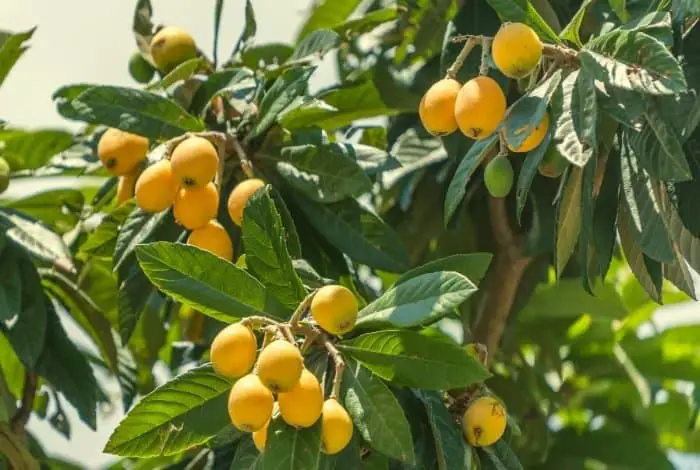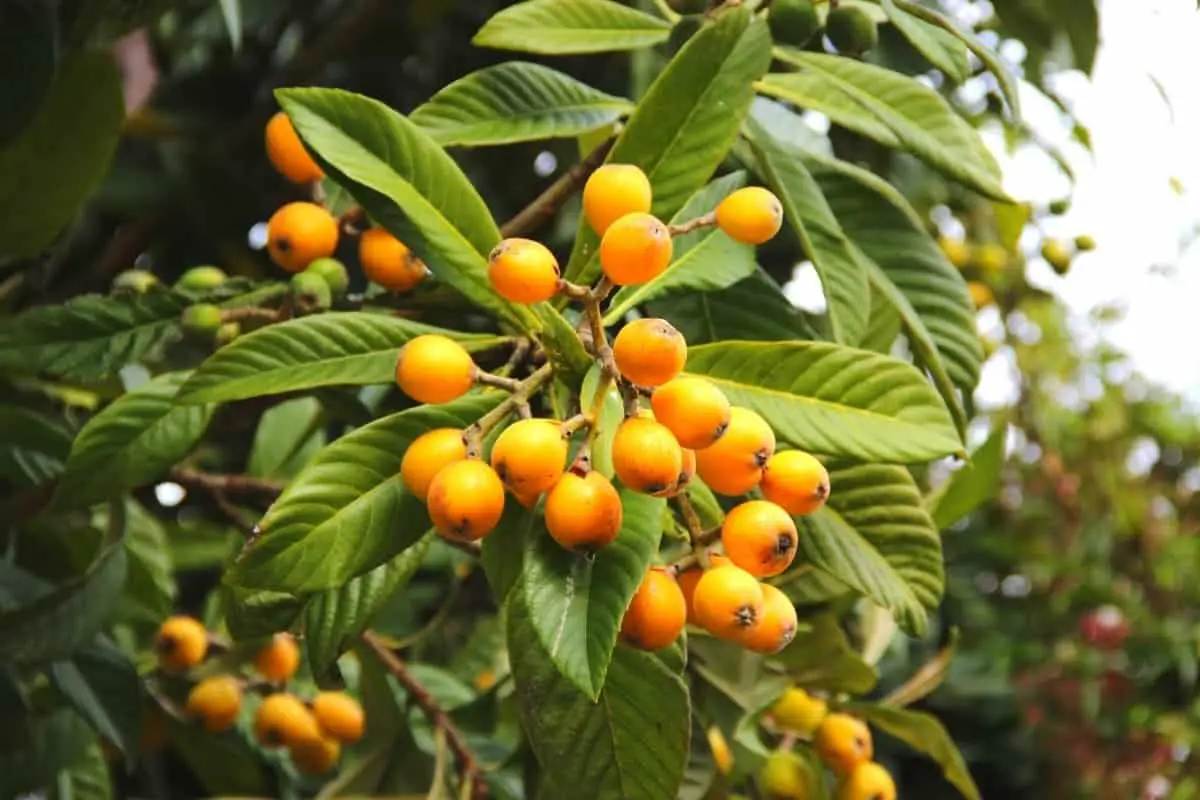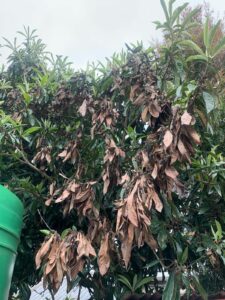Last Updated on December 28, 2022 by Griselda M.
Growing loquat trees in pots are easy and a popular choice among many gardeners who want an attractive fruit-bearing tree.
Loquats are large evergreen small trees that can grow up to 20-30 feet tall but most of them only reach about 10 feet or slightly larger. They are easy to grow! They are loved for their production of sweet and tangy fruits that are plum-sized.
Loquat Trees
Loquat fruits are oval, round, or pear-shaped 1-2 inches long with a smooth yellow or orange skin. The flesh is white, orange, or yellow depending on the cultivar. The fruit is juicy and thick-skinned which is a favorite to many. It can be eaten fresh with the skin peeled off or turned into loquat jam.
Loquats are also known as Japanese Plums and Japanese Medler. Their botanical name is Eriobotrya japonica. This fruit is a member of the pome family and a cousin to quinces, apples, and pears. It contains 2-3 black seeds in the middle of the orange or yellow flesh.

Loquats trees do well in USDA Hardiness zones 8-10 and they can tolerate temperatures of as low as 10 degrees Fahrenheit. These temperatures will kill flowers and fruit, however.
Find out The Best Fertilizer for the Unique Meyer Lemon Tree
How to Grow Loquat Trees in Pots
Growing loquat trees in pots are possible as we will see below. Let’s look at a step-by-step guide.
- Choose a pot that is at least 600 mm wide.
- Place it in full sun and fill it with a quality potting mix of your choice.
- Take the shrub from the container and gently ease the roots into the pot. If there are any tangled roots, cut them off.
- Position the plant in a hole and fill it with the potting mix as you gently firm it down. Water it generously to help it absorb the transplanting shock.
- Water well at least 2 times a week depending on weather conditions
- Mulch around the base using organic mulch like bark chips to keep it from drying fast
- You can add fertilizer thrice yearly, in spring, summer, and autumn.
- When it gets to the flowering stage, feed it weekly with fruit plant food to help promote more flowering and fruiting.
- Re-pot annually to prevent plants from becoming root-bound.
- A loquat tree is a great choice for the patio area. But avoid planting them where the fruit can drop on sidewalks or patios.
Miracle-Gro Continuous Release Plant Food Plus Calcium
How to Take Care of Loquat Trees in Pots
Loquats are shallow-rooted plants. Do not disturb their roots when weeding and put mulch around the base to protect them.
Water these trees regularly to help them produce juicy fruits. Loquats are drought-tolerant but they do well with regular watering. Do not overwater; it makes the soil wet all the time and kills the plant. Keep the soil evenly moist. When the blossoms are swelling and during harvest time, remember to water during this season.
Fertilize the loquat trees 3 times a year in spring, winter, and autumn with 6-6-6 organic fertilizers.
Avoid high-nitrogen fertilizers because they can reduce flowering. After mid-summer, do not fertilize the trees.
Pruning loquats is important after harvesting. Prune back the shoots to keep them free from growing too tall. Remove the dead, diseased, crossing branches and dense shoots that grow in the center of the plant.
This ensures that sunlight reaches ripening fruit. Severe pruning does not harm loquats.
Maybe you are interested in reading about How To Get Rid Of Carpenter Ants In Trees.
Loquat Varieties to Grow in Containers
Orange Fleshed Cultivars
- Early Red. Medium-large, pear-shaped fruits form in small clusters. They are ore orange-fleshed with orange-red skin with white dots. This type ripens in winter.
- Big Jim. Round to oblong fruit that is 1 ½ inch in diameter. It has pale orange-yellow skin that is easy to peel. Its orange-yellow flesh has a very good slightly tart flavor. It ripens in mid-spring.
- Mrs. Cooksey. A large fruit of about 1 ½ inch in diameter with a yellow flesh and excellent flavor.
- Gold Nugget. A large, rounded oblong fruit with yellow-orange thin skin. This type’s orange flesh is juicy, firm, and sweet and its flavor is similar to an apricot.
White Fleshed Cultivars
- Champagne. Medium to large oval fruit with deep yellow skin and white flesh. It melts with sweetness and is very juicy and has a good flavor. This type ripens in late spring.
- Advance. A medium to large pear-shaped fruit with deep yellow thick skin and white flesh. It ripens later in winter to early spring. Its tree is a dwarf of about 5 feet tall and resistant to fire blight.
- Herd’s Mammoth. Large fruit with yellow-orange skin and white-cream-colored flesh. It ripens earlier than other types.
- Vista White. A small to medium-sized fruit with yellow skin and white flesh. It is very sweet and superb for dessert.
If you are already growing loquat trees, share your experience with us. If these tips were useful, do not forget to share.
How to Save a Dying Loquat Tree?
There are a few simple things that can cause a loquat tree to die.
Underwatering
Feel the soil – if it is dry, and the leaves are a bit yellow and small, water the tree more. If this helps you know it was a watering issue that caused your tree damage.
Overwatering
Feel the soil – if it is very wet and soggy, you may have overwatered your loquat tree. If your soil was not good and did not contain sand and pearlite, the roots can get waterlogged and the tree will suffer and drop leaves. Stop watering and let the soil dry out. Plant a few radishes in the soil under the tree and water again. The radishes will grow and help to moderate the soil moisture. This encourages the loquat to grow its roots back into the surface where it feeds and the tree will recover.
Shot hole borer
This pest kills loquat trees. You will see whole branches that die, and go brown while other branches are alive. Inspect the branches and look for lots of little holes in the branch. Shot hole borer kills trees and they do not recover. Cut the tree down, and burn the wood. Remove all the soil from the pot and replant a tree. Keep your tree healthy and it will resist shot hole borer.
Here is an example of one of my bigger loquat trees that are currently infested with a Shothole borer and will die in a year or so. The beetle transmits a fungus into the branches and with time the whole tree will turn brown and die.
What Kind of Soil Does a Loquat Tree Need?
A loquat will grow in nearly any soil. I have grown huge trees in hard clay, sea sand, river sand, and compost. They grow very well in compost-rich sandy soil with pearlite added.
Do Loquat Trees Like Coffee Grounds?
Yes – do not go overboard, as coffee grounds can burn plants if added in large quantities. Just make a few small holes in the soil and put half a cup here and half a cup there. Make sure you have earthworms in your soil. These will move the nutrients around.
When Do You Transplant Loquat Trees?
The best time to transplant loquat trees is in spring. This allows them to get a nice growing season in before they slow down for winter.
What is The Lifespan of a Loquat Tree?
The trees I have grown, or my parents have grown, have lasted at least 35 – 40 years. I know older trees. According to other facts on the internet, the average lifespan is about 20-30 years. I think that this is a bit low.
How Often Do Loquat Trees Fruit?
This just depends on your area and your climate. My loquat bears fruit once to twice a year depending on rainfall. In wet years it fruits more often. It takes about three months from flower to fruit. I have friends in warmer countries such as Reunion who seem to get three crops a year.
Where Are Loquat Trees From?
The tree appears to have originated in China and has slowly been bred to produce more edible fruit. It then spread around the world and is actually an invasive pest in a lot of countries. Loquats produce huge crops of fruit and seeds and birds and monkeys distribute these widely, leading to the trees becoming invasive.
In conclusion – Growing Loquat Trees In Pots
A loquat tree is a beautiful plant with lovely strong leaves and delicious fruit. There are many cultivars to choose from. The trees can tolerate moderate cold but do better in climates where minimum temperatures do not drop below 55°F for long periods. For potted loquats, you can move your plants indoors if you live in a colder area, and if you are lucky you will have winter fruit on your tree!
Caroline is a gardener who loves to get down to the nitty–gritty of gardening. She proudly proclaims herself as a ‘dirt worshipper‘ and can often be found deep in the garden, covered in soil and singing to her plants. As a self–proclaimed ‘plant whisperer‘, Caroline believes that plants need love and attention just like any other living thing, and she loves to give them both. When she‘s not tending to her garden, you can often find her researching the latest gardening trends, or teaching others how to make their gardens thrive



